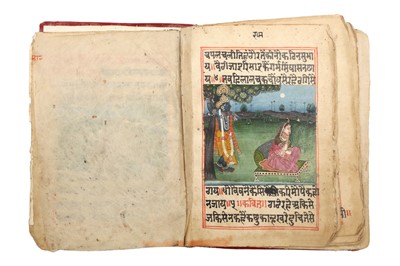28th Oct, 2022 14:00
Islamic & Indian Art
A SECTION OF AN ILLUSTRATED MANUSCRIPT ON RADHA AND KRISHNA'S LOVE STORY
Possibly Jaipur, Rajasthan or Jaipur artist active in Bundelkhand, Central India, ca. 1790 - 1810
A SECTION OF AN ILLUSTRATED MANUSCRIPT ON RADHA AND KRISHNA'S LOVE STORY
PROPERTY FROM A PRIVATE AMERICAN COLLECTION
Possibly Jaipur, Rajasthan or Jaipur artist active in Bundelkhand, Central India, ca. 1790 - 1810
Hindu manuscript on paper, 27ff., with 4 to 14ll. of black and red ink Devanagari script to the page, the text accompanied by twenty-one polychrome-painted and gilt illustrations featuring Lord Krishna, his beloved Radha and the gopis in several scenes typical of manuscripts narrating Krishna and Radha's love story like the Gitagovinda, Maan Madhuri, Krishna Lila, and Bhakti poetical compendia, each illustration incorporated in the text within the text panel delineated with double red rules, no further marginal illuminations or decorative devices, set in a later binding lined with red-dyed cotton fabric, a devotional steam-pressed icon of Ram Durbar and printed prayers to Krishna pasted on the inner covers, the text panel 10.3cm x 16cm, the page 14cm x 19.5cm.
Provenance: German Private Collection.
The paintings in this manuscript appear to be the work of an unrecorded Indian artist named Ramcharan Kayasth, who is also associated with an important illustrated Ramayana manuscript, once in the collection of Lakshmibai, the Rani of Jhansi, recently sold at Christie's London, 12 June 2018, lot 76. Whilst the present lot is a much more modest and smaller commission, both in terms of page count and subject, the two manuscripts showcase a number of analogous features, indicating they could have been produced by the same hand at approximately the same time.
First of all, both books followed the ‘gutka’ format, an infrequent style of Hindu ‘upright’ and bound manuscript, different from the usual horizontal format. According to Losty, this format 'was brought to perfection in the late 18th century, above all in the Jaipur Royal Library’ with the aim to equal contemporary Muslim manuscripts (Jeremiah P. Losty, The Art of the Book in India, 1982, cat.129, p.145). Despite the different sizes of the illustrations, double red rules encase the text in both manuscripts, giving a very schematic and neat look to the page. Besides a few exceptions, the characters in both the Ramayana and Krishna manuscripts are depicted in profile stands, a quintessential feature of Rajasthani paintings in the late 18th and early 19th centuries. That said, the choice of chromatic palette and careful use of shading, adding extra volume and depth to the figures, is rather peculiar and goes against the 'flat' style introduced by the well-known Jaipuri master Sahib Ram (active 1778 - 1803), suggesting either a foreign influence or an extravagant artistic license enabled by the painter.
Although it is unclear where both manuscripts were produced and if Kayasath was active in Jaipur or elsewhere, their overall style speaks of a hybrid mixture of elements derived from Indian painting schools in both northern and central provinces, standing out as a unique and unusual expression of the pictorial arts of India.
Sold for £1,250
Includes Buyer's Premium
Do you have an item similar to the item above? If so please click the link below to submit a free online valuation request through our website.
















